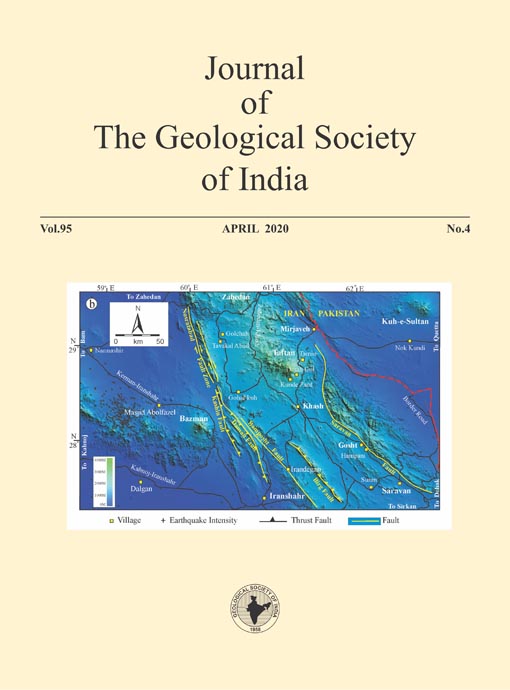Evaluation of Ranikot Sandstone Formation, Punjab Platform Basin Pakistan
DOI:
https://doi.org/10.1007/s12594-020-1449-5Keywords:
No Keywords.Abstract
The Ranikot sandstone Formation was investigated using TOC and Rock-Eval pyrolysis measurements. Ranikot Formation encountered in Bijnot well, Fort Abbas has been evaluated, which lies in Bahawalpur, middle Indus basin, particularly in Punjab platform. Analysis has been performed on sandstones, twenty well cutting samples of Ranikot Formation has been evaluated. Formation is predominantly sandstone with interbeds of shale. The analysed samples contains TOC ranging from 0.76-3.1 wt.%, The S2 values of Rock-Eval shows poor potential with values ranging from 0.46-1.05 mg HC/g rock. The samples have low hydrogen index values ranging from 21-113 mg HC/g TOC. Kerogen is predominantly Type III land derived organic matter. The analysed samples have Tmax ranging from 413-509 °C. The upper part of formation from 490-560 m depth generally exhibits good to very good TOC content and is in the transition between immature and mature zone (Tmax 430-431 °C). The genetic potential in the entire rock unit is poor <2.0 mg HC/g rock. On the basis of analysis performed the studied samples have shown that the formation has poor potential.Downloads
Metrics
Issue
Section
Downloads
Published
How to Cite
References
Aadil, N. and Sohail, G.M. (2014) 3D geological modelling of Punjab Platform, Middle Indus Basin Pakistan through Integration of wireline Logs and seismic data. Jour. Geol. Soc. India, v.83(2), pp.211-217.
Ahmed, W. and Alam, S. (1999) Organic geochemistry and source rock characteristics of Salt Range Formation, Potwar Basin: Presented at Annual Technical Conference (ATC), Islamabad, October 1999, pp.25-49.
Espitalié, J., Laporte, J.L., Madec, M., Marquis, F., Leplat, P., Pauletand, J., et al. (1977) Methode rapide de caracterisation des roches meres, de leur potential petrolier et de leur degre d'evolution. Revue de l'Institut Francais du Petrole, v.32, pp.23-42.
Fazeelat, T., Jalees, M.I. and Bianchi, T.S. (2010) Source rock potential of Eocene, Paleocene and Jurassic deposits in the subsurface of the Potwar Basin, northern Pakistan. Jour. Petrol. Geol., v.33(1), pp.87-96.
Hasany, S.T., Aftab, M. and Siddiqui, R.A. (2007) Refound exploration opportunities in Infracambrian and Cambrian sediments of Punjab Platform, Pakistan. In Annual Technical Conference, Islamabad, Pakistan. Proceedings, pp.31-62.
Hasany, S.T., Aftab, M. and Siddiqui, R.A. (2007) Refound exploration opportunities in Infracambrian and Cambrian sediments of Punjab Platform, Pakistan. In: Annual Technical Conference, Islamabad, Pakistan. Proceedings (pp. 31-62).
Kadri, I.B. (1995) Petroleum Geology of Pakistan. Pakistan Petroleum Limited.
Kemal, A., Balkwill, H.R. and Stoakes, F.A. (1991) Indus Basin hydrocarbon plays. In New directions and strategies for accelerating petroleum exploration and production in Pakistan: Proceedings, International Petroleum Seminar (pp.76-105).
Kvenvolden, K.A. and McDonald, T.J. (1986) Organic Geochemistry on the Joides Resolution: An Assay. Ocean Drilling Program, Texas A & M University.
Magoon, L.B. and Dow, W.G. (1991) The petroleum system-from source to trap. AAPG Bull (American Association of Petroleum Geologists); (United States), 75(CONF-910403-)
Oil and Gas Development Corporation [OGDC] (1996) Pakistan petroleum prospects ” An overview: Islamabad, Oil and Gas Development Corporation, 22p.
Peters, K.E. and Cassa, M.R. (1994) Applied source rock geochemistry. In: Magoon, L.B., Dow, W.G. (Eds.), The Petroleum System - From Source to Trap. AAPG Mem., v.60, pp.93-120.
Peters, K.E, Clark, M.E., Das Gupta, U., McCaffrey, M.A. and Lee, C.Y. (1995) Recognition of an infracambrian source rock based on biomarkers in the Baghewala-1 Oil, India: AAPG Bull., v.79/10, pp.1481-1494.
Quadri, V.N. and Quadri, S.M.J.G. (1998) Failure-to-success targets may lie in Pakistan basins: Oil and Gas Journal archives, v.96, i. 1, [accessed 3/2/ 2000 at URL ].
Raza, H.A., Ahmad, W., Ali, S.M., Mujtaba, M., Alam, S., Shafeeq, M., ... and Riaz, N. (2008) Hydrocarbon Prospects of Punjab Platform Pakistan, with special reference to Bikaner-Nagaur Basin of India. Pakistan Jour. Hydrocarbon Res., 18, pp.1-33.
Raza, H.A., Ahmed, Riaz, Alam, Shaji, and Ali, S.M. (1989) Petroleum zones of Pakistan: Pakistan Jour. Hydrocarbon Res., v.1(2), p.21-56.
Shah, S. B. A. and Abdullah, W. H. (2016) Petrophysical properties and hydrocarbon potentiality of Balkassar well 7 in Balkassar oilfield, Potwar Plateau, Pakistan. Bull. Geol. Soc. Malaysia, v.62, pp.73-77.
Shah, S.B.A. and Abdullah, W.H. (2017) Structural interpretation and hydrocarbon potential of Balkassar oil field, eastern Potwar, Pakistan, using seismic 2D data and petrophysical analysis. Jour. Geol. Soc. India, v.90(3), pp.323-328.
Shah, S.B.A. and Ahmed, A. (2018) Hydrocarbon source rock potential of Paleocene and Jurassic deposits in the Panjpir oilfield subsurface, Punjab Platform, Pakistan. Arabian Jour. Geosci., v.11(20), pp.607.
Shah, S.B.A., Abdullah, W.H. and Shuib, M.K.B. (2019) Petrophysical properties evaluation of Balkassar oilfield, Potwar Plateau, Pakistan: implication for reservoir characterization. Himalayan Geol., v.40(1), pp.50-57.
Shah, S.I. (2009) Stratigraphy of Pakistan. Government of Pakistan Ministry of Petroleum & Natural Resources Geological Survey of Pakistan.
Tissot, B.P. and Welte, D.H. (1984) Petroleum Formation and Occurrence. Second ed., Springer, New York.
Wandrey, C.J., Law, B.E. and Shah, H. A. (2004). Patala-Nammal composite total petroleum system, Kohat-Potwar geologic province, Pakistan. US Department of the Interior, US Geological Survey.

 Syed Bilawal Ali Shah
Syed Bilawal Ali Shah






